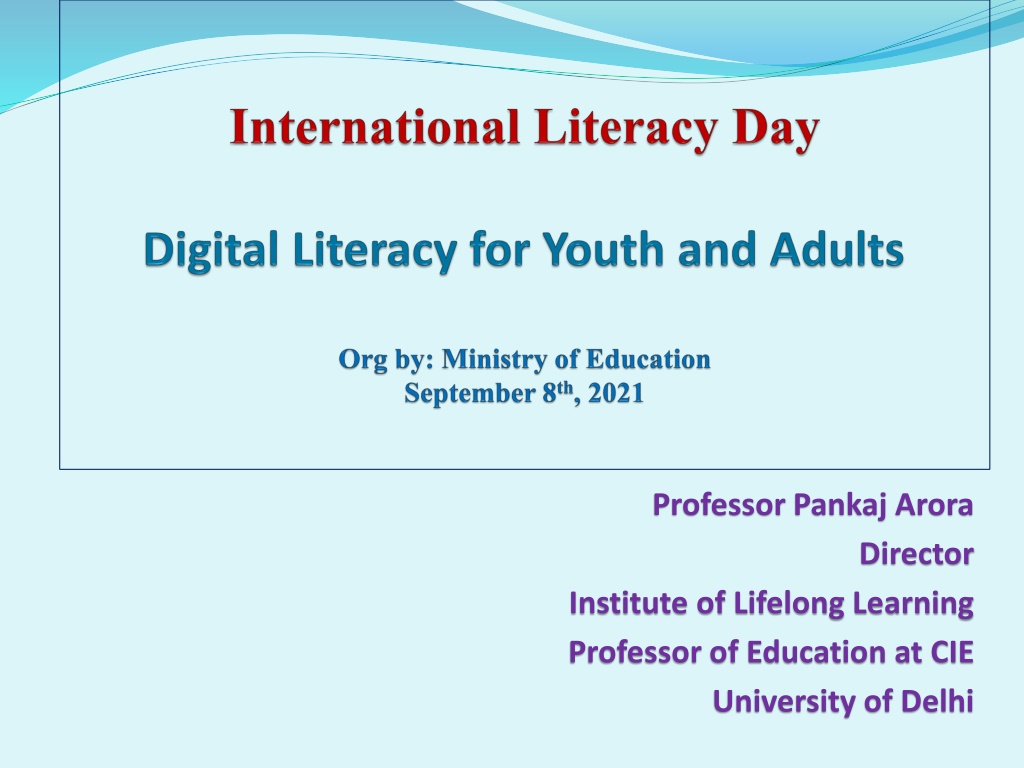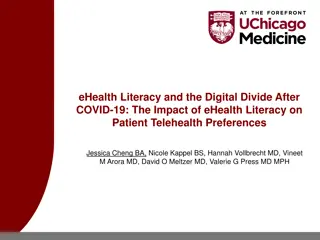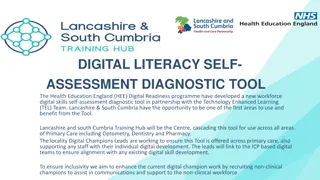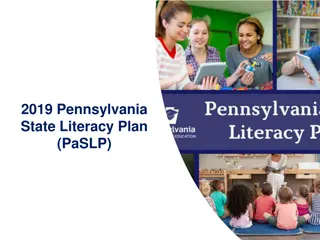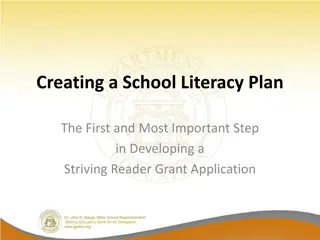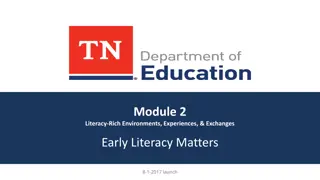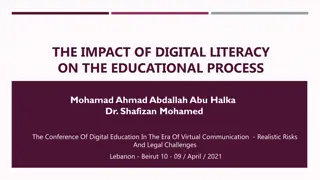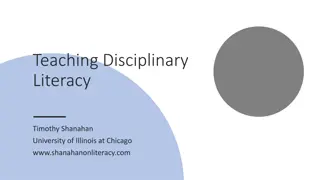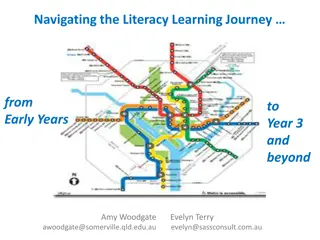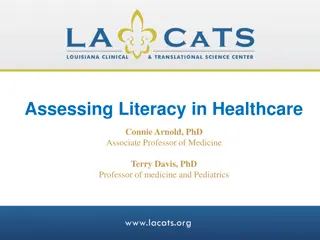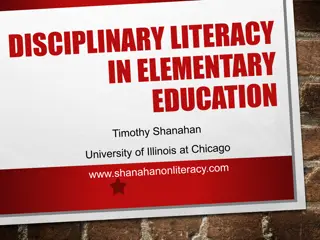Understanding Digital Literacy in Education and Everyday Life
Digital literacy, essential in today's digital age, refers to the ability to utilize, create, and evaluate digital content effectively. It involves critical engagement with technology, social awareness, and adaptability. The scope of digital literacy is vast, impacting various aspects of daily life, from education to entertainment and beyond.
Download Presentation

Please find below an Image/Link to download the presentation.
The content on the website is provided AS IS for your information and personal use only. It may not be sold, licensed, or shared on other websites without obtaining consent from the author. Download presentation by click this link. If you encounter any issues during the download, it is possible that the publisher has removed the file from their server.
E N D
Presentation Transcript
Professor Pankaj Arora Director Institute of Lifelong Learning Professor of Education at CIE University of Delhi
Meaning of Digital Literacy (DL) An ability to find, evaluate, utilize, share, and create content using information technologies and the Internet"(www.digitalliteracy.cornell.edu, 2015). Digital literacy is the ability to interpret and design nuanced across fluid digital forms. This refers to the evolving digital and social media applications, including, but not limited to, search engines, medical blogs, Twitter, YouTube, Facebook, Wikipedia, and other social media channels. communication
Digital literacy involves critically engaging with technology and developing a social awareness of how a number of factors including commercial agendas and cultural understandings can shape the ways in which technology is used to convey information and meaning. It means being able to communicate and represent knowledge in different contexts and to different audiences (for example, in visual, audio or textual modes). This involves finding and selecting relevant information, critically re-contextualising knowledge and is underpinned by an understanding of the cultural and social contexts in which this takes place. evaluating and
In short..DL means.. A constellation of life skills (Hobbs, 2010, p. vii) given the diverse definitions, uses, purposes, and contexts in which these literacies are applied. NEP (Chapter 24) Online and Digital Education: Ensuring Equitable Use of Technology 24.1. New circumstances and realities require new initiatives. The recent rise in epidemics and pandemics necessitates that we are ready with alternative modes of quality education whenever and wherever traditional and in-person modes of education are not possible.
Nature of DL The nature of digital literacy is being comfortable using digital technologies Having the ability to decide which piece of equipment or software is right for the job in hand. Enable to effectively use appropriate technology, infrastructure of that applications/software to access the services you require. You must also be respectful and safe in all you do within the digital world just as you would in the physical world. technology and its
Scope of Digital Literacy The scope or use of digital literacy touches all aspects of our everyday lives. It is all encompassing in terms of its scope. In fact, it is very difficult to think of an element of our lives that is not affected by digital technology. With apps and software to help us find a job or a partner, use the household appliances to booking theatre or cinema tickets, holidays and getting the best deals possible on the shopping sites.
Digital Literacy and Youth Young people are increasingly engaging with new technologies and digital media. There is clearly a role for online youth work practice, in terms of exploiting a new space for youth work in a meaningful way, supporting digital literacy and enabling young people to deal with some of the associated risks Digital literacy gives young people the ability to take advantage of the wealth of new and emerging opportunities associated with digital technologies whilst also remaining alert to the various challenges technology can present. In short, digital literacy is the savvyness that allows young people to participate meaningfully and safely as digital technology becomes ever more pervasive in society. Schools are also increasingly encouraged to embed the use of ICT in all subject areas across both the primary and secondary curricula. Now, Digital literacy is all over in the classroom can help young mind to expand and extend their use of technology for creativity and self- expression and to develop a greater understanding of the complexities of what they re doing.
Take learning everywhere Engagement with peers/ Interactive Blogs (Civics & AE) Work at their own pace Importance of Digital Literacy Constant connection with teachers Inclusive and Barrier free learning Decreases behavior issues
WHY SHOULD WE CARE ABOUT Digital Literacy? Young people are already engaging with digital technologies and digital media and using them to find information and communicate meaning in different modes and formats and this provides significant opportunities and challenges that it is important to address. Young people need to be prepared for a successful adulthood in a world increasingly saturated with digital technologies. Developing digital literacy can help students to access subject knowledge at a time when digital technologies are changing the way knowledge is created and communicated. It can also help schools to engage with children s lived experiences and existing knowledge as well as extending and diversifying this experience and knowledge to make learning more relevant and purposeful. Not all young people are equally equipped with the skills knowledge and understanding that will allow them to critically engage with technology and to use it well. There is an increasing policy emphasis on developing student s digital literacy across the curriculum. It is the ability to make and share meaning in different modes and formats; to create, collaborate and communicate effectively and to understand how and when digital technologies can best be used to support these processes.
Digital Literacy and University of Delhi ILLL: The vision of the ILLL is to emerge and make a mark in the realms of lifelong learning and higher education through information and communication technology across the world. DUDISCAD: Delhi University Digital Infrastructure Support for Colleges and Departments . OneDU: The essence of the these objectives is to enhance accessibility to learning, foster best practices, and development, by harnessing the benefits of available educational technologies. SOL (1962): Complete virtualization - Online Classrooms, e-Learning Students to have their own Tablets, Study material available over the Cloud Technology, Online Continuous Assessment. COL: Centre for Professional and Technical Training is an industrial training institute under the aegis of Campus of Open Learning, University of Delhi and is established to offer job-oriented and skill based vocational courses in various professional fields with view to offer internships and employment opportunities to the youth with the assistance of training partners. promote professional
To promote digital literacy and to minimize digital divide we should work towards making Right to Technology as an integral part of Right of Education THANK YOU! pankajcie@yahoo.com
